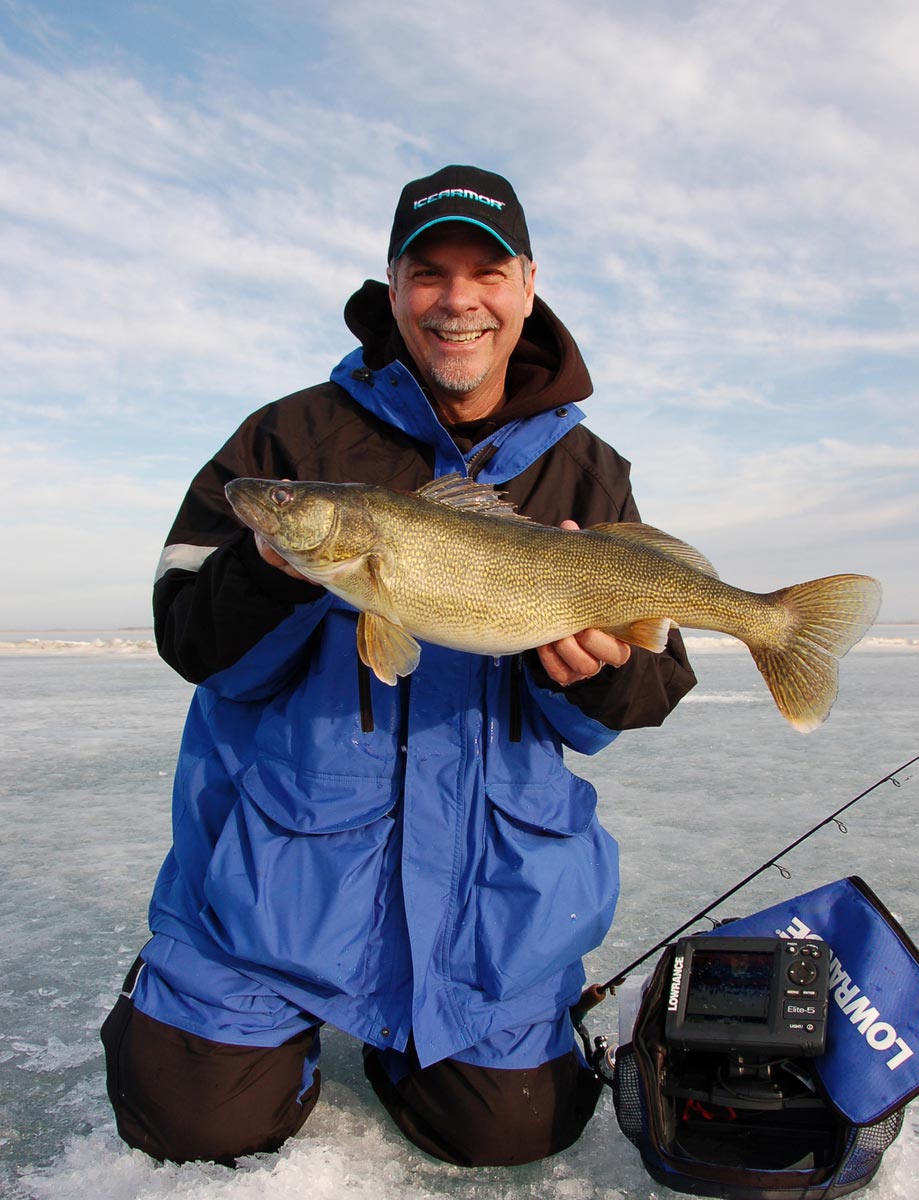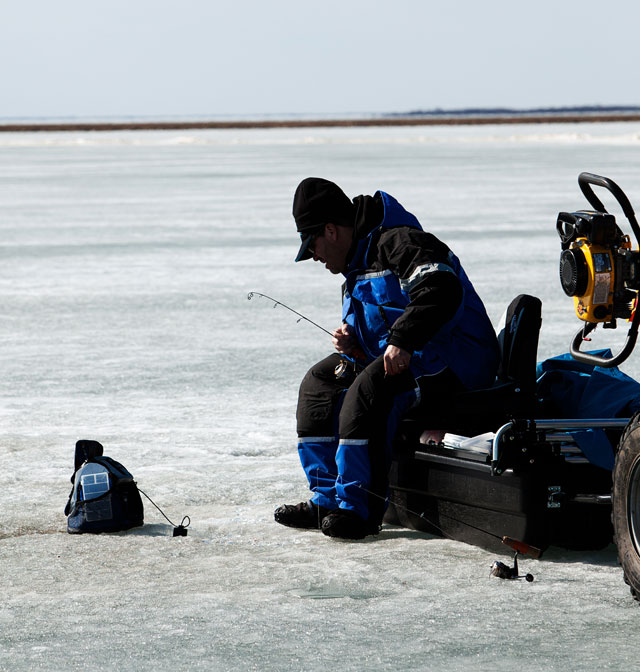There seems to be two schools of thought when it comes to what approach is best for catching mid-winter walleyes. Basically you’ve got the “Sitters” and the “Runners”. Sitters are a patient lot … staking out a particular spot on the lake, drilling a few strategically placed holes, setting a few tip-ups and with jig rod in hand, wait for the fish to come to them. Then there are the Runners; the ones that approach their ice fishing like a wolf pack with a mission.
 No doubt that by the time you are reading this article, ice fishing season will be well underway throughout most of walleye country. Ice fishing is a great and popular winter sport, but it can be a frustrating for many avid walleye anglers. Sure, species like panfish and pike are active and relatively easy to catch in mid-winter, but walleyes often prove tougher to catch with any consistency. It’s not that the walleyes are any less active under the ice than those other species, but, as it is in many cases during the open water season, finding these fish and using the right presentations is key to putting ‘eyes on the ice.
No doubt that by the time you are reading this article, ice fishing season will be well underway throughout most of walleye country. Ice fishing is a great and popular winter sport, but it can be a frustrating for many avid walleye anglers. Sure, species like panfish and pike are active and relatively easy to catch in mid-winter, but walleyes often prove tougher to catch with any consistency. It’s not that the walleyes are any less active under the ice than those other species, but, as it is in many cases during the open water season, finding these fish and using the right presentations is key to putting ‘eyes on the ice.
There seems to be two schools of thought when it comes to what approach is best for catching mid-winter walleyes. Basically you’ve got the “Sitters” and the “Runners”. Sitters are a patient lot … staking out a particular spot on the lake, drilling a few strategically placed holes, setting a few tip-ups and with jig rod in hand, wait for the fish to come to them. Then there are the Runners; the ones that approach their ice fishing like a wolf pack with a mission. These anglers systematically turn potential hot spots into Swiss cheese-like slabs of ice, drilling hole after hole. Their mission is to hunt down the walleyes in their wintry lair with a “run-and-gun” attitude. Armed with power ice augers, plenty of gas, jigging rods and lures, these anglers are looking to cover water and trigger bites.
Is one of these groups going to be more successful than the other? The answer is yes and no … the secret to consistent success is being versatile enough to do both, each at the right time.
When it comes to ice fishing for walleyes, there’s a time to be a “Sitter”, and a time to be a “Runner”. Walleyes are not much different under the ice than they are during the warmer months of the year … that is to say; they are generally most active during the low light periods around dusk and dawn. When the fish are active and on the move, that’s the time for anglers to be “Sitters”, waiting in key areas to intersect the walleyes as they forage. These areas may be a saddle area between islands, the edges of sunken humps, or on a point … anywhere where anglers are likely to catch fish moving from deeper water to feeding flats.
As the day progresses, walleyes will become less mobile, and relate closely to structure not far from their feeding areas. These types of spots could include irregularities on breaks, cups, or deep transition areas. This is the time to become a “Runner”, because now is the time to take the game to the fish, searching out these holding areas to contact and trigger biters. Since it’s rare to find a good concentration of fish that’ll bite at this time, you’re likely to only get one fish here, and one fish there. That’s why the “run and gun” approach gives you the best chance at finding numbers of walleyes.
 Regardless of whether you’re a “Sitter” or a “Runner”, gearing up right is imperative to success. Electronics have become a major part of the modern ice fishing scene. Anglers have taken what they learn from using GPS and sonar locators on their boats and utilized the knowledge and the technology to improve their ice fishing successes. A full-color, GPS/Fishfinder combo unit like the Lowrance Elite-5 Ice Machine gives ice anglers every advantage one would want from their fishing electronics. Although flashers were once thought to be the fishfinder of choice for ice angling, LCD units like the Elite-5 have several advantages and are quickly eclipsing flashers in popularity. One big advantage; while a flasher can show you when a fish comes into your cone, you must be looking at the unit at that specific moment, or you’ll miss it. With a LCD, the image is “recorded” and scrolled across the screen, so if you happen to look away from the unit for a few seconds, you could miss an all important fish entering the cone. By using the LCD when you look back at the unit, you will still see what happened when you weren’t looking, and in fact you can scroll back to check out what you might have missed! Another advantage is that you can very quickly interpret the size of the fish coming into your cone by the signal indicated on the screen, the same way we do when using these units on our boats in open water.
Regardless of whether you’re a “Sitter” or a “Runner”, gearing up right is imperative to success. Electronics have become a major part of the modern ice fishing scene. Anglers have taken what they learn from using GPS and sonar locators on their boats and utilized the knowledge and the technology to improve their ice fishing successes. A full-color, GPS/Fishfinder combo unit like the Lowrance Elite-5 Ice Machine gives ice anglers every advantage one would want from their fishing electronics. Although flashers were once thought to be the fishfinder of choice for ice angling, LCD units like the Elite-5 have several advantages and are quickly eclipsing flashers in popularity. One big advantage; while a flasher can show you when a fish comes into your cone, you must be looking at the unit at that specific moment, or you’ll miss it. With a LCD, the image is “recorded” and scrolled across the screen, so if you happen to look away from the unit for a few seconds, you could miss an all important fish entering the cone. By using the LCD when you look back at the unit, you will still see what happened when you weren’t looking, and in fact you can scroll back to check out what you might have missed! Another advantage is that you can very quickly interpret the size of the fish coming into your cone by the signal indicated on the screen, the same way we do when using these units on our boats in open water.
Those are great advantages for stationary anglers, but there are advantages for the anglers in “run and gun” mode as well. The use of a portable depth finder helps to quickly locate depth and key structural areas, dramatically reducing the time wasted fishing unproductive areas. After all, ice fishing has a relatively small window of opportunity, and taking advantage of technology can go a long way to help one make the most of their time on the ice.
Mid-winter can also bring with it some very nasty weather. Your choice of outerwear and shelter on the ice can mean the difference between a comfortable day of fishing or a miserable time in the outdoors. Over the years we have worn every conceivable cold weather suit made and we can confidently say that the IceArmor Ultra Parka and Bibs are the best out there. Built to last, these suits keep out the cold and wet, with tons of features every angler can appreciate including super-tough knee patches, a well designed hood system and lots of pockets just to name a few.
Ice fishing for walleyes in mid-winter doesn’t have to be a frustrating adventure. Think about all the equipment and gear you use to improve your summer walleye fishing, and take a bit of that mind-set into your winter fishing. Learn when to be a “Sitter”, and when to be a “Runner”, and you’ll warm up your winter days getting your Next Bite.










